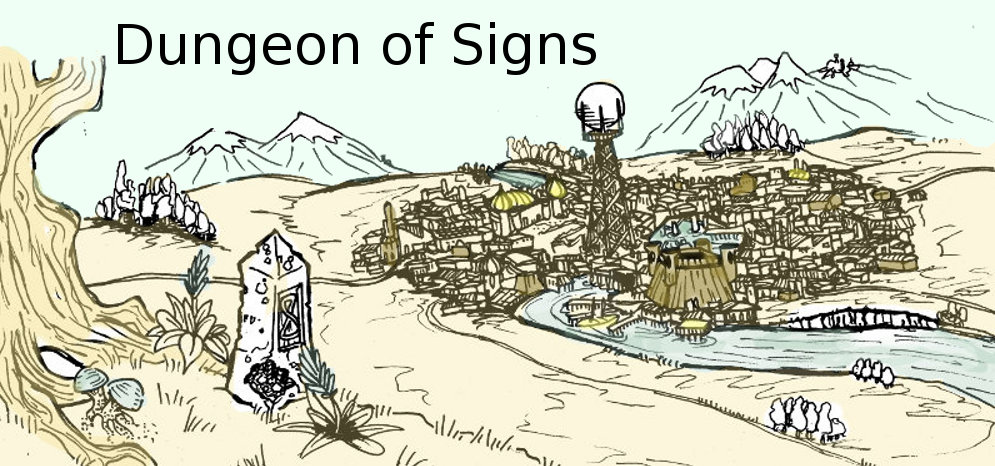AREA I - Primary Entrance Hatch
|
Lighting
|
Soft Yellow light
fills the room from a chandelier of metal orbs, but leaves the chambers recesses
in deep shadow.
|
|
Odors
|
Faintly musty, with
a hint of a sweet perfume like odor.
|
|
Traps
|
None
|
|
Treasure
|
Chandelier Ancient metal globe chandelier,
worth (300GP), will take 2D6 turns to remove safely. Weighs 200lbs and bulky.
|
|
Encounters
|
None
|
|
|
|
Several feet below the murky waters of the
slough a mound of earth and rust colored alien fungus almost completely covers
this ancient alloy tube, set with a round set of double doors. The doors are two feet thick, a forged of
ancient alloy stronger than steel, and cannot be opened easily by force, a
difficulty that is increased because they are submerged. The doors a sealed with a mechanical lock,
which though made of ancient technology and so resistant to force (requires a
roll under Strength at +15) to force with tools, can be picked by a competent
thief or opened by magic (Knock).
 |
|
Fungal Zombies Lurk in the Darkness
|
Beyond the doors is a 10’ diameter alloy
tube that will rotate to act as an airlock, once the outer hatch is closed,
revealing a domed chamber extending Westward in the form of an oval, 60’ long
and 30’ wide. Water from the airlock
will quickly drain through grates around the edges of the room’s slightly
concave floor and once drained (1 turn) reentering the tube will cause it to
rotate, again facing the exit hatch. The
chamber is empty, except for a few encrustations of teal and cyan fungus on the
ceiling and walls.
The walls, floor and ceiling of the domed
chamber are themselves made of a smooth white glazed ceramicrete. The only sign of decoration in the entry
chamber are a set of benches molded into the longer walls and a dangling chandelier
of metal globes hanging in the center.
The chandelier is heavy and worth only a few hundred GP as a curiosity
if a dedicated individual spends 2D6 turns carefully pulling, prying and
cutting it from the ceiling.
An archway partially overhung with the
thumb thick tendrils of cyan fungus provides the only interior exit to the
entry chamber and leads down a twisting and uneven 180’ stair that descends at
least 40’ into the darkness. Along the
stairway, molded into the cermicrete walls are the mottos “Through Adversity to
the Stars”, “From the Stars Knowledge”, and “The Conqueror Returns”.
AREA II - Chamber of Arrival
|
Lighting
|
Dimly lit by the
soft amber glow of the central crystal
|
|
Odors
|
Damp, rot and a
sweet perfume odor that increases in the Western half of the room.
|
|
Traps
|
Teleportation
Crystal Instantly
transports to area IX if touched by hand.
|
|
Treasure
|
Panels (200 x 50 GP) panels require
time and luck to remove, each ways 25lbs and is bulky.
Quartz Crystal (25 GP)
|
|
Encounters
|
None
|
|
|
|
The stairs from AREA I disgorge
into a huge rounded vault, 80’ in diameter with a ceiling lost over 100’ above
in the gloom. Drips of rank water
occasionally fall due to seepage from the slough, and light shined upward will
reveal ropey, striped (yellow and brown) fungus snaking from above, though none
reach more than 20’ from the floor. The
room itself has walls made of a greyish alloy, molded into bas reliefs of man’s
conquest of space. Moving clockwise from the archway that leads to the long
stair this sculpture show: Sputnik floating above the earth, The eagle lander,
Astronauts on the moon, Scientists toiling in a laboratory, Rockets emerging
from silos, Men in space suits battling four armed Tharks, Rocket ships
battling above a canal covered world, Spaceman tortured on a giant wheel by bug
eyed amazons, Beasts surround a
submarine in the frozen seas of Uranus, Robots marching on a crater rim
fortress, A supernova, Identical women
stand in formation armed with sabers, Yuri Garagrin emerging from a sunburst
and A giant rocket dreadnaught battling a swarm of saucers. While fascinating, these panels conceal no
secrets, though they can be pried from the walls with great care and
considerable force, to reveal girders of black alloy beneath.
Individual panels are worth 50 GP each to
the wealthy of Denethix for decorative purposes, but while the alloy is sturdy
it tenders to shatter if torqued and each panel will take 1D6+2 turns to
remove, requiring a successful D20 roll under Int -2 to avoid destroying. There a 50 panels in all, though many simply
show geometric designs vaguely resembling starscapes.
In the center of the room floats a strange
crystal growth, at roughly chest height.
It is a cloudy white, but vague clouds of amber light move within the
crystal’s depths. The crystal is
suspended by an amber beam of light three inches wide and cannot be knocked
free by a blow doing less than 20 HP of damage (AC 2). Nor can it be grabbed, as it is a terminal
for a teleportation system, immediately whisking anyone who touches it to AREA
IX. Is somehow removed the crystal loses
its magical appearance and proves to be a large lump of quartz worth 25 GP.
A stairway with ornate alloy hand rails leads
down to AREA VI. On the Eastern wall of the chamber is a hatch almost identical
to the one leading to the surface. It is
sealed from this side, but will open if the same tonal key is used as in AREA
I, leading to AREA III.











